Investment Appraisal: Sensitivity Analysis & Capital Budgeting Project
VerifiedAdded on 2023/04/23
|11
|2437
|367
Report
AI Summary
This report provides a detailed analysis of sensitivity and scenario analysis in the context of capital budgeting. It explains the concepts of both analyses, highlighting their advantages and disadvantages in evaluating project viability. Furthermore, the report calculates key financial metrics such as Net Present Value (NPV), Internal Rate of Return (IRR), payback period, discounted payback period, and profitability index for a proposed project. The calculations indicate a positive NPV and a favorable IRR, suggesting the project's financial viability and potential for increasing the organization's profitability. The report concludes that the investment appraisal techniques support the acceptance of the project for investment purposes, emphasizing its potential to generate high income from operations.
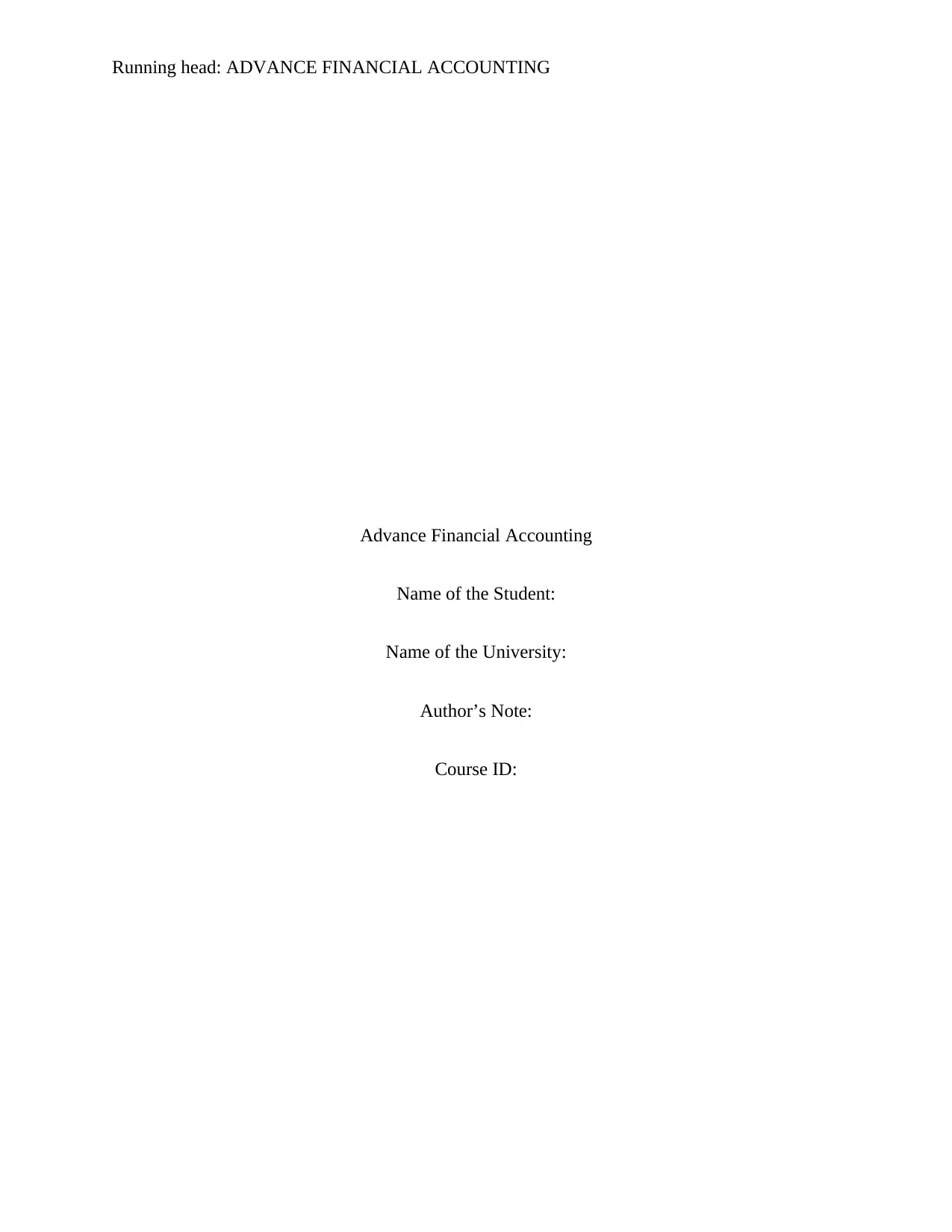
Running head: ADVANCE FINANCIAL ACCOUNTING
Advance Financial Accounting
Name of the Student:
Name of the University:
Author’s Note:
Course ID:
Advance Financial Accounting
Name of the Student:
Name of the University:
Author’s Note:
Course ID:
Paraphrase This Document
Need a fresh take? Get an instant paraphrase of this document with our AI Paraphraser

1ADVANCE FINANCIAL ACCOUNTING
Table of Contents
Question 1:.......................................................................................................................................2
a) Explaining the concept of Sensitivity Analysis:..........................................................................2
b) Explaining the concept of Scenario analysis in capital budgeting process:................................3
Question 2: Calculating the net present value, IRR, Payback period, discounted payback period
and profitability index of the proposed project................................................................................5
References and Bibliography:..........................................................................................................8
Table of Contents
Question 1:.......................................................................................................................................2
a) Explaining the concept of Sensitivity Analysis:..........................................................................2
b) Explaining the concept of Scenario analysis in capital budgeting process:................................3
Question 2: Calculating the net present value, IRR, Payback period, discounted payback period
and profitability index of the proposed project................................................................................5
References and Bibliography:..........................................................................................................8
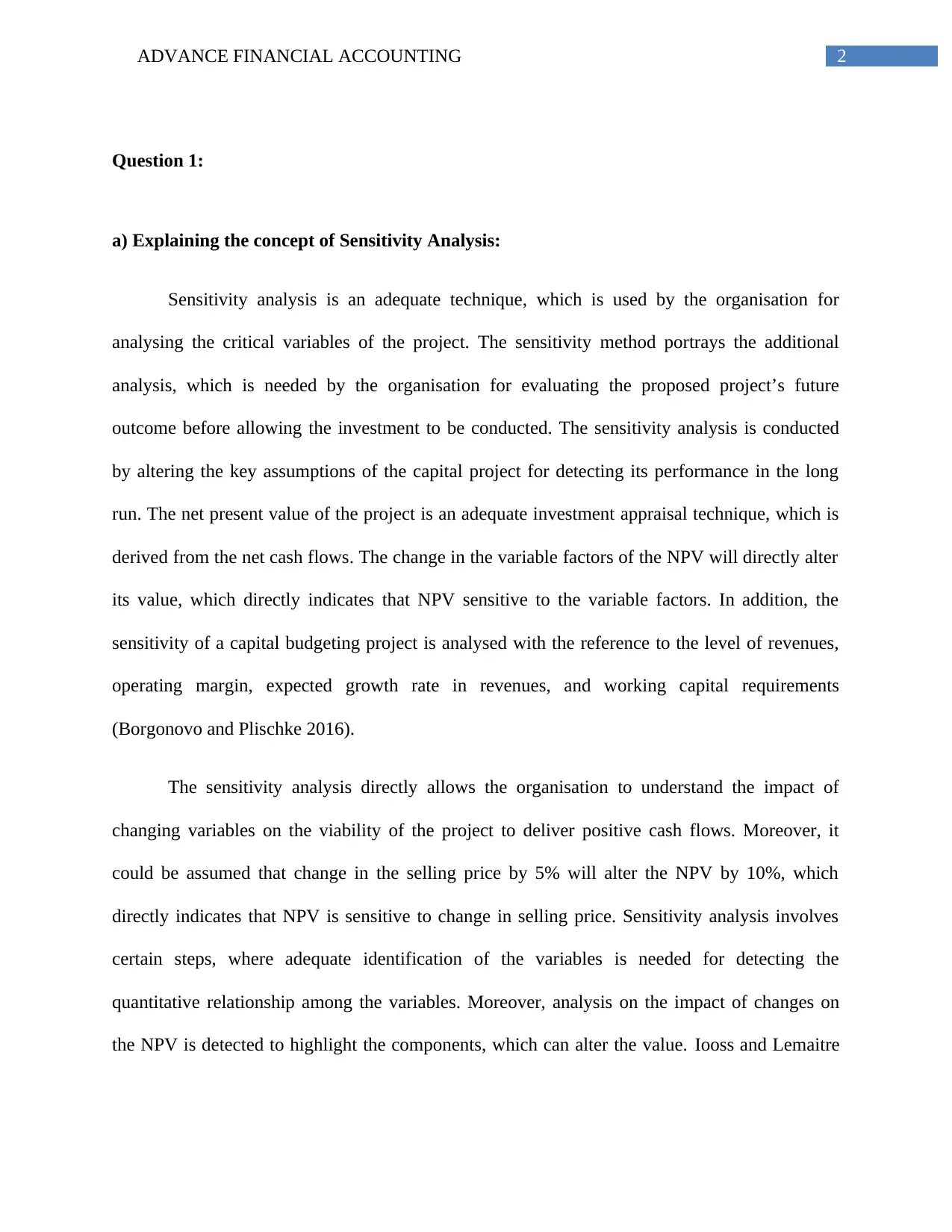
2ADVANCE FINANCIAL ACCOUNTING
Question 1:
a) Explaining the concept of Sensitivity Analysis:
Sensitivity analysis is an adequate technique, which is used by the organisation for
analysing the critical variables of the project. The sensitivity method portrays the additional
analysis, which is needed by the organisation for evaluating the proposed project’s future
outcome before allowing the investment to be conducted. The sensitivity analysis is conducted
by altering the key assumptions of the capital project for detecting its performance in the long
run. The net present value of the project is an adequate investment appraisal technique, which is
derived from the net cash flows. The change in the variable factors of the NPV will directly alter
its value, which directly indicates that NPV sensitive to the variable factors. In addition, the
sensitivity of a capital budgeting project is analysed with the reference to the level of revenues,
operating margin, expected growth rate in revenues, and working capital requirements
(Borgonovo and Plischke 2016).
The sensitivity analysis directly allows the organisation to understand the impact of
changing variables on the viability of the project to deliver positive cash flows. Moreover, it
could be assumed that change in the selling price by 5% will alter the NPV by 10%, which
directly indicates that NPV is sensitive to change in selling price. Sensitivity analysis involves
certain steps, where adequate identification of the variables is needed for detecting the
quantitative relationship among the variables. Moreover, analysis on the impact of changes on
the NPV is detected to highlight the components, which can alter the value. Iooss and Lemaitre
Question 1:
a) Explaining the concept of Sensitivity Analysis:
Sensitivity analysis is an adequate technique, which is used by the organisation for
analysing the critical variables of the project. The sensitivity method portrays the additional
analysis, which is needed by the organisation for evaluating the proposed project’s future
outcome before allowing the investment to be conducted. The sensitivity analysis is conducted
by altering the key assumptions of the capital project for detecting its performance in the long
run. The net present value of the project is an adequate investment appraisal technique, which is
derived from the net cash flows. The change in the variable factors of the NPV will directly alter
its value, which directly indicates that NPV sensitive to the variable factors. In addition, the
sensitivity of a capital budgeting project is analysed with the reference to the level of revenues,
operating margin, expected growth rate in revenues, and working capital requirements
(Borgonovo and Plischke 2016).
The sensitivity analysis directly allows the organisation to understand the impact of
changing variables on the viability of the project to deliver positive cash flows. Moreover, it
could be assumed that change in the selling price by 5% will alter the NPV by 10%, which
directly indicates that NPV is sensitive to change in selling price. Sensitivity analysis involves
certain steps, where adequate identification of the variables is needed for detecting the
quantitative relationship among the variables. Moreover, analysis on the impact of changes on
the NPV is detected to highlight the components, which can alter the value. Iooss and Lemaitre
⊘ This is a preview!⊘
Do you want full access?
Subscribe today to unlock all pages.

Trusted by 1+ million students worldwide

3ADVANCE FINANCIAL ACCOUNTING
(2015) mentioned that with the help sensitivity analysis companies are able to understand the
level of alternations that can be made by the variable components of the project.
There are specific advantages and disadvantages of the sensitivity analysis, which can
help in detecting the financial viability of the project. The major advantage of sensitivity analysis
is the benefit it gives to the organisation in viewing a greater visibility to the weak spot in an
investment. This detection of the weakness mainly helps in understanding the level of
improvements that needs to be conducted for raising the performance of the proposed project.
The second advantage of sensitivity analysis is that it allows the management to critically
investigate factors that validate the assumptions of the project. Moreover, the sensitivity analysis
aids the management in making proper decision regarding commencement of the project (Ding
and VanderWeele 2016).
The major disadvantage of sensitivity analysis is that variable is often interdependent,
which make the examining of the components for each individually unrealistic. Moreover, the
sensitivity analysis is based on past data, which might not be effective in future. Furthermore, the
sensitivity analysis is open to subjective interpretation and risk preference, which is different for
each individual or the decision maker. Moreover, the sensitivity analysis method is not
considered as risk measuring or risk reducing technique. Hence, it could be understood that by
using the sensitivity analysis the organisation is not able to gather clear decision rule for the
investment (Pianosi, Sarrazin and Wagener 2015).
b) Explaining the concept of Scenario analysis in capital budgeting process:
The scenario analysis is an effective measure that allows the organisation to evaluate the
performance of the project under number of scenarios. The scenario analysis is considered to be
(2015) mentioned that with the help sensitivity analysis companies are able to understand the
level of alternations that can be made by the variable components of the project.
There are specific advantages and disadvantages of the sensitivity analysis, which can
help in detecting the financial viability of the project. The major advantage of sensitivity analysis
is the benefit it gives to the organisation in viewing a greater visibility to the weak spot in an
investment. This detection of the weakness mainly helps in understanding the level of
improvements that needs to be conducted for raising the performance of the proposed project.
The second advantage of sensitivity analysis is that it allows the management to critically
investigate factors that validate the assumptions of the project. Moreover, the sensitivity analysis
aids the management in making proper decision regarding commencement of the project (Ding
and VanderWeele 2016).
The major disadvantage of sensitivity analysis is that variable is often interdependent,
which make the examining of the components for each individually unrealistic. Moreover, the
sensitivity analysis is based on past data, which might not be effective in future. Furthermore, the
sensitivity analysis is open to subjective interpretation and risk preference, which is different for
each individual or the decision maker. Moreover, the sensitivity analysis method is not
considered as risk measuring or risk reducing technique. Hence, it could be understood that by
using the sensitivity analysis the organisation is not able to gather clear decision rule for the
investment (Pianosi, Sarrazin and Wagener 2015).
b) Explaining the concept of Scenario analysis in capital budgeting process:
The scenario analysis is an effective measure that allows the organisation to evaluate the
performance of the project under number of scenarios. The scenario analysis is considered to be
Paraphrase This Document
Need a fresh take? Get an instant paraphrase of this document with our AI Paraphraser
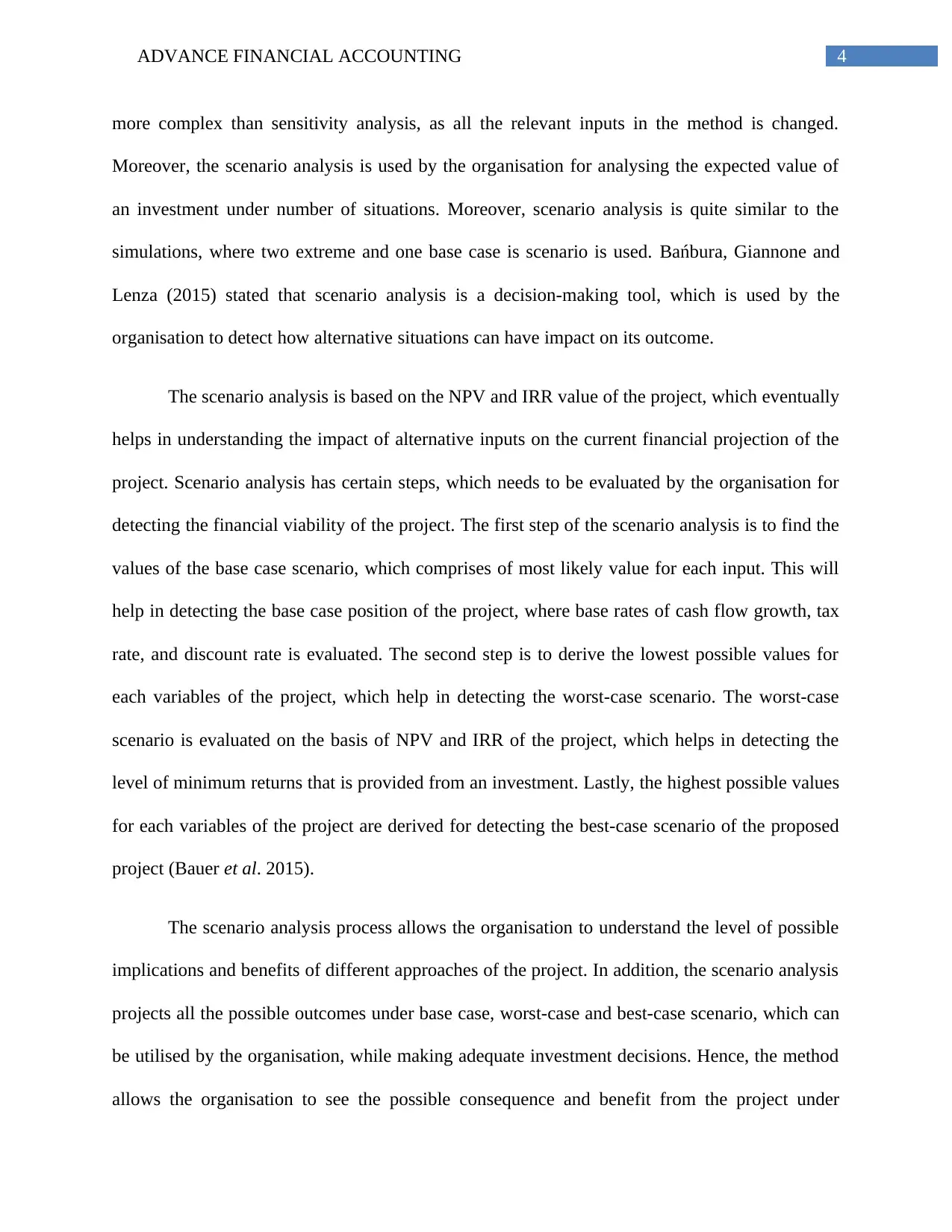
4ADVANCE FINANCIAL ACCOUNTING
more complex than sensitivity analysis, as all the relevant inputs in the method is changed.
Moreover, the scenario analysis is used by the organisation for analysing the expected value of
an investment under number of situations. Moreover, scenario analysis is quite similar to the
simulations, where two extreme and one base case is scenario is used. Bańbura, Giannone and
Lenza (2015) stated that scenario analysis is a decision-making tool, which is used by the
organisation to detect how alternative situations can have impact on its outcome.
The scenario analysis is based on the NPV and IRR value of the project, which eventually
helps in understanding the impact of alternative inputs on the current financial projection of the
project. Scenario analysis has certain steps, which needs to be evaluated by the organisation for
detecting the financial viability of the project. The first step of the scenario analysis is to find the
values of the base case scenario, which comprises of most likely value for each input. This will
help in detecting the base case position of the project, where base rates of cash flow growth, tax
rate, and discount rate is evaluated. The second step is to derive the lowest possible values for
each variables of the project, which help in detecting the worst-case scenario. The worst-case
scenario is evaluated on the basis of NPV and IRR of the project, which helps in detecting the
level of minimum returns that is provided from an investment. Lastly, the highest possible values
for each variables of the project are derived for detecting the best-case scenario of the proposed
project (Bauer et al. 2015).
The scenario analysis process allows the organisation to understand the level of possible
implications and benefits of different approaches of the project. In addition, the scenario analysis
projects all the possible outcomes under base case, worst-case and best-case scenario, which can
be utilised by the organisation, while making adequate investment decisions. Hence, the method
allows the organisation to see the possible consequence and benefit from the project under
more complex than sensitivity analysis, as all the relevant inputs in the method is changed.
Moreover, the scenario analysis is used by the organisation for analysing the expected value of
an investment under number of situations. Moreover, scenario analysis is quite similar to the
simulations, where two extreme and one base case is scenario is used. Bańbura, Giannone and
Lenza (2015) stated that scenario analysis is a decision-making tool, which is used by the
organisation to detect how alternative situations can have impact on its outcome.
The scenario analysis is based on the NPV and IRR value of the project, which eventually
helps in understanding the impact of alternative inputs on the current financial projection of the
project. Scenario analysis has certain steps, which needs to be evaluated by the organisation for
detecting the financial viability of the project. The first step of the scenario analysis is to find the
values of the base case scenario, which comprises of most likely value for each input. This will
help in detecting the base case position of the project, where base rates of cash flow growth, tax
rate, and discount rate is evaluated. The second step is to derive the lowest possible values for
each variables of the project, which help in detecting the worst-case scenario. The worst-case
scenario is evaluated on the basis of NPV and IRR of the project, which helps in detecting the
level of minimum returns that is provided from an investment. Lastly, the highest possible values
for each variables of the project are derived for detecting the best-case scenario of the proposed
project (Bauer et al. 2015).
The scenario analysis process allows the organisation to understand the level of possible
implications and benefits of different approaches of the project. In addition, the scenario analysis
projects all the possible outcomes under base case, worst-case and best-case scenario, which can
be utilised by the organisation, while making adequate investment decisions. Hence, the method
allows the organisation to see the possible consequence and benefit from the project under
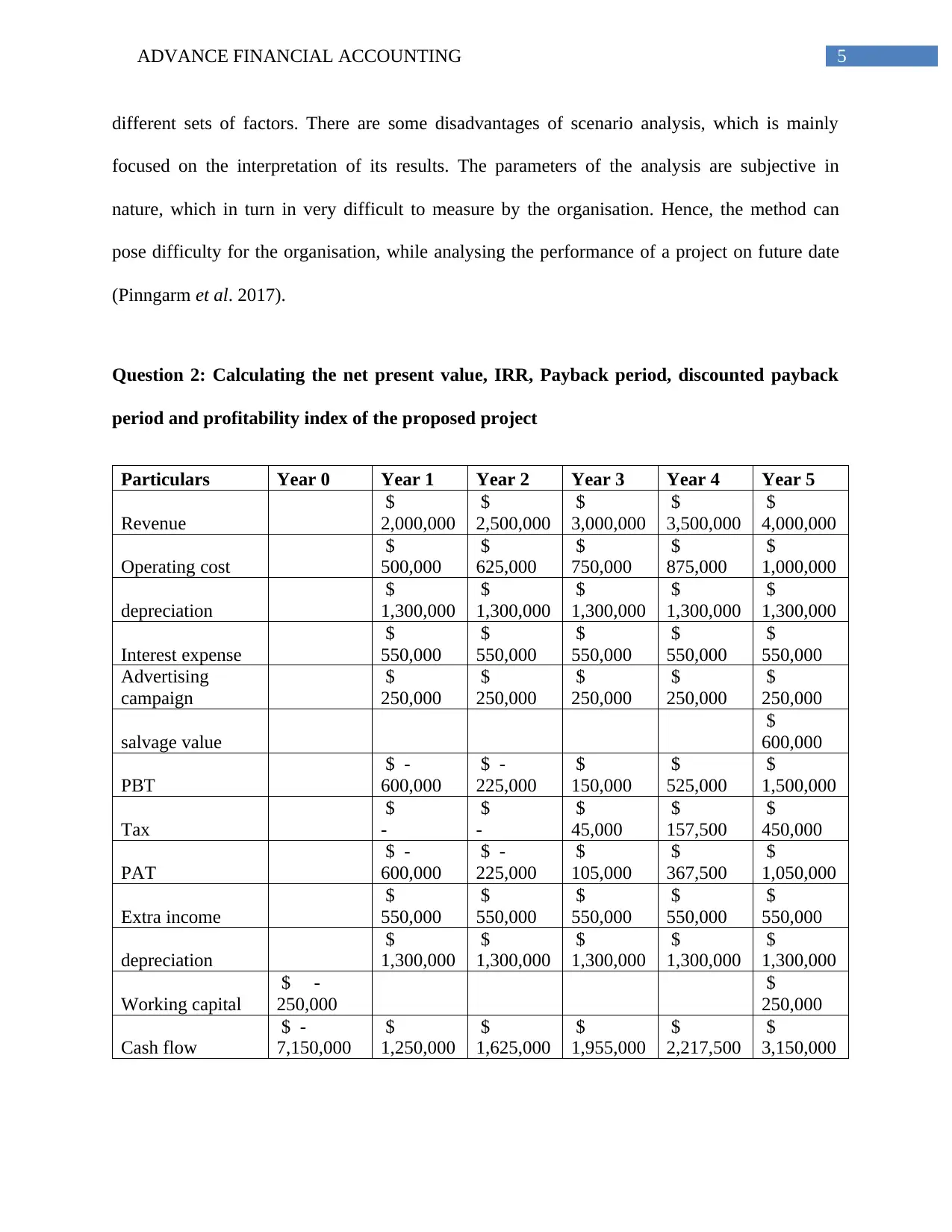
5ADVANCE FINANCIAL ACCOUNTING
different sets of factors. There are some disadvantages of scenario analysis, which is mainly
focused on the interpretation of its results. The parameters of the analysis are subjective in
nature, which in turn in very difficult to measure by the organisation. Hence, the method can
pose difficulty for the organisation, while analysing the performance of a project on future date
(Pinngarm et al. 2017).
Question 2: Calculating the net present value, IRR, Payback period, discounted payback
period and profitability index of the proposed project
Particulars Year 0 Year 1 Year 2 Year 3 Year 4 Year 5
Revenue
$
2,000,000
$
2,500,000
$
3,000,000
$
3,500,000
$
4,000,000
Operating cost
$
500,000
$
625,000
$
750,000
$
875,000
$
1,000,000
depreciation
$
1,300,000
$
1,300,000
$
1,300,000
$
1,300,000
$
1,300,000
Interest expense
$
550,000
$
550,000
$
550,000
$
550,000
$
550,000
Advertising
campaign
$
250,000
$
250,000
$
250,000
$
250,000
$
250,000
salvage value
$
600,000
PBT
$ -
600,000
$ -
225,000
$
150,000
$
525,000
$
1,500,000
Tax
$
-
$
-
$
45,000
$
157,500
$
450,000
PAT
$ -
600,000
$ -
225,000
$
105,000
$
367,500
$
1,050,000
Extra income
$
550,000
$
550,000
$
550,000
$
550,000
$
550,000
depreciation
$
1,300,000
$
1,300,000
$
1,300,000
$
1,300,000
$
1,300,000
Working capital
$ -
250,000
$
250,000
Cash flow
$ -
7,150,000
$
1,250,000
$
1,625,000
$
1,955,000
$
2,217,500
$
3,150,000
different sets of factors. There are some disadvantages of scenario analysis, which is mainly
focused on the interpretation of its results. The parameters of the analysis are subjective in
nature, which in turn in very difficult to measure by the organisation. Hence, the method can
pose difficulty for the organisation, while analysing the performance of a project on future date
(Pinngarm et al. 2017).
Question 2: Calculating the net present value, IRR, Payback period, discounted payback
period and profitability index of the proposed project
Particulars Year 0 Year 1 Year 2 Year 3 Year 4 Year 5
Revenue
$
2,000,000
$
2,500,000
$
3,000,000
$
3,500,000
$
4,000,000
Operating cost
$
500,000
$
625,000
$
750,000
$
875,000
$
1,000,000
depreciation
$
1,300,000
$
1,300,000
$
1,300,000
$
1,300,000
$
1,300,000
Interest expense
$
550,000
$
550,000
$
550,000
$
550,000
$
550,000
Advertising
campaign
$
250,000
$
250,000
$
250,000
$
250,000
$
250,000
salvage value
$
600,000
PBT
$ -
600,000
$ -
225,000
$
150,000
$
525,000
$
1,500,000
Tax
$
-
$
-
$
45,000
$
157,500
$
450,000
PAT
$ -
600,000
$ -
225,000
$
105,000
$
367,500
$
1,050,000
Extra income
$
550,000
$
550,000
$
550,000
$
550,000
$
550,000
depreciation
$
1,300,000
$
1,300,000
$
1,300,000
$
1,300,000
$
1,300,000
Working capital
$ -
250,000
$
250,000
Cash flow
$ -
7,150,000
$
1,250,000
$
1,625,000
$
1,955,000
$
2,217,500
$
3,150,000
⊘ This is a preview!⊘
Do you want full access?
Subscribe today to unlock all pages.

Trusted by 1+ million students worldwide
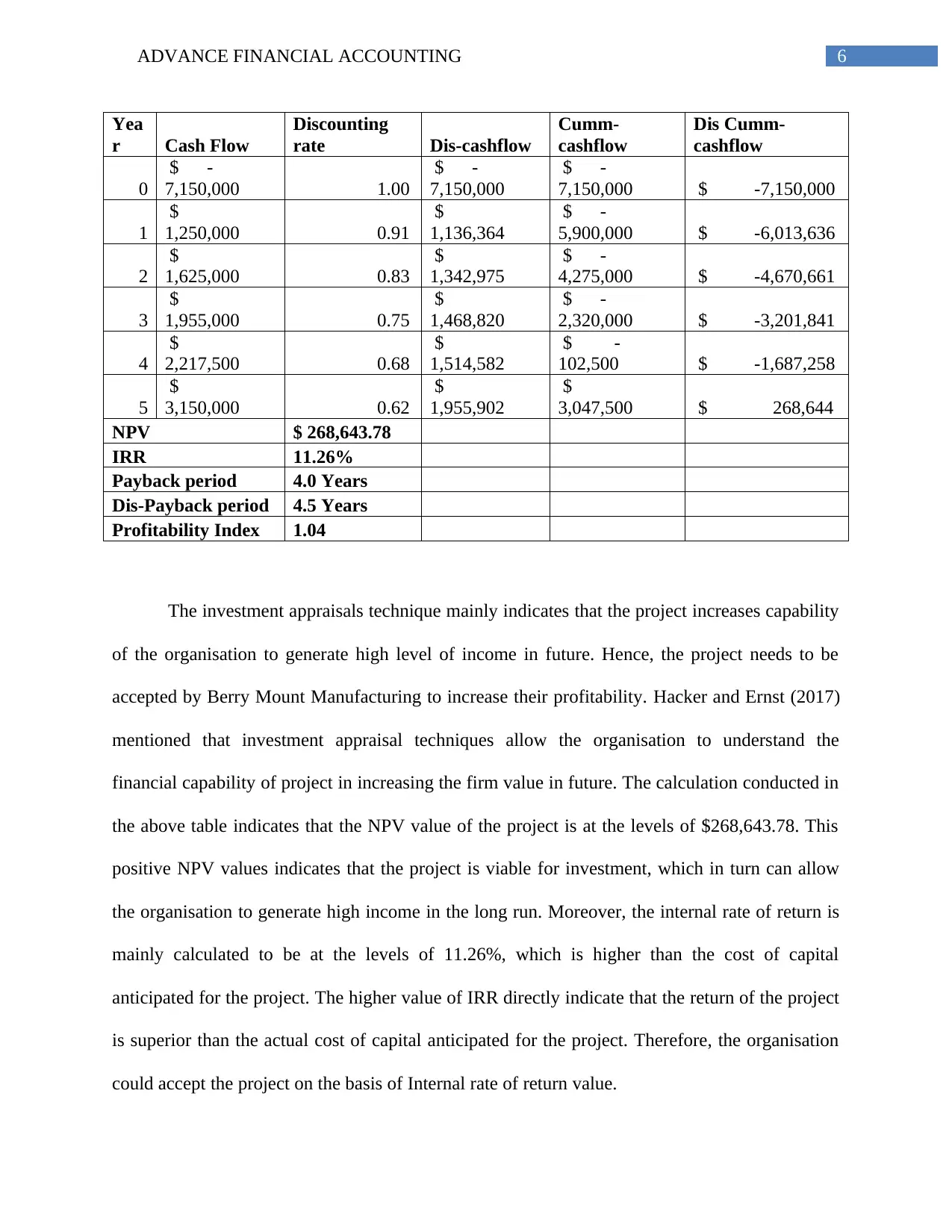
6ADVANCE FINANCIAL ACCOUNTING
Yea
r Cash Flow
Discounting
rate Dis-cashflow
Cumm-
cashflow
Dis Cumm-
cashflow
0
$ -
7,150,000 1.00
$ -
7,150,000
$ -
7,150,000 $ -7,150,000
1
$
1,250,000 0.91
$
1,136,364
$ -
5,900,000 $ -6,013,636
2
$
1,625,000 0.83
$
1,342,975
$ -
4,275,000 $ -4,670,661
3
$
1,955,000 0.75
$
1,468,820
$ -
2,320,000 $ -3,201,841
4
$
2,217,500 0.68
$
1,514,582
$ -
102,500 $ -1,687,258
5
$
3,150,000 0.62
$
1,955,902
$
3,047,500 $ 268,644
NPV $ 268,643.78
IRR 11.26%
Payback period 4.0 Years
Dis-Payback period 4.5 Years
Profitability Index 1.04
The investment appraisals technique mainly indicates that the project increases capability
of the organisation to generate high level of income in future. Hence, the project needs to be
accepted by Berry Mount Manufacturing to increase their profitability. Hacker and Ernst (2017)
mentioned that investment appraisal techniques allow the organisation to understand the
financial capability of project in increasing the firm value in future. The calculation conducted in
the above table indicates that the NPV value of the project is at the levels of $268,643.78. This
positive NPV values indicates that the project is viable for investment, which in turn can allow
the organisation to generate high income in the long run. Moreover, the internal rate of return is
mainly calculated to be at the levels of 11.26%, which is higher than the cost of capital
anticipated for the project. The higher value of IRR directly indicate that the return of the project
is superior than the actual cost of capital anticipated for the project. Therefore, the organisation
could accept the project on the basis of Internal rate of return value.
Yea
r Cash Flow
Discounting
rate Dis-cashflow
Cumm-
cashflow
Dis Cumm-
cashflow
0
$ -
7,150,000 1.00
$ -
7,150,000
$ -
7,150,000 $ -7,150,000
1
$
1,250,000 0.91
$
1,136,364
$ -
5,900,000 $ -6,013,636
2
$
1,625,000 0.83
$
1,342,975
$ -
4,275,000 $ -4,670,661
3
$
1,955,000 0.75
$
1,468,820
$ -
2,320,000 $ -3,201,841
4
$
2,217,500 0.68
$
1,514,582
$ -
102,500 $ -1,687,258
5
$
3,150,000 0.62
$
1,955,902
$
3,047,500 $ 268,644
NPV $ 268,643.78
IRR 11.26%
Payback period 4.0 Years
Dis-Payback period 4.5 Years
Profitability Index 1.04
The investment appraisals technique mainly indicates that the project increases capability
of the organisation to generate high level of income in future. Hence, the project needs to be
accepted by Berry Mount Manufacturing to increase their profitability. Hacker and Ernst (2017)
mentioned that investment appraisal techniques allow the organisation to understand the
financial capability of project in increasing the firm value in future. The calculation conducted in
the above table indicates that the NPV value of the project is at the levels of $268,643.78. This
positive NPV values indicates that the project is viable for investment, which in turn can allow
the organisation to generate high income in the long run. Moreover, the internal rate of return is
mainly calculated to be at the levels of 11.26%, which is higher than the cost of capital
anticipated for the project. The higher value of IRR directly indicate that the return of the project
is superior than the actual cost of capital anticipated for the project. Therefore, the organisation
could accept the project on the basis of Internal rate of return value.
Paraphrase This Document
Need a fresh take? Get an instant paraphrase of this document with our AI Paraphraser
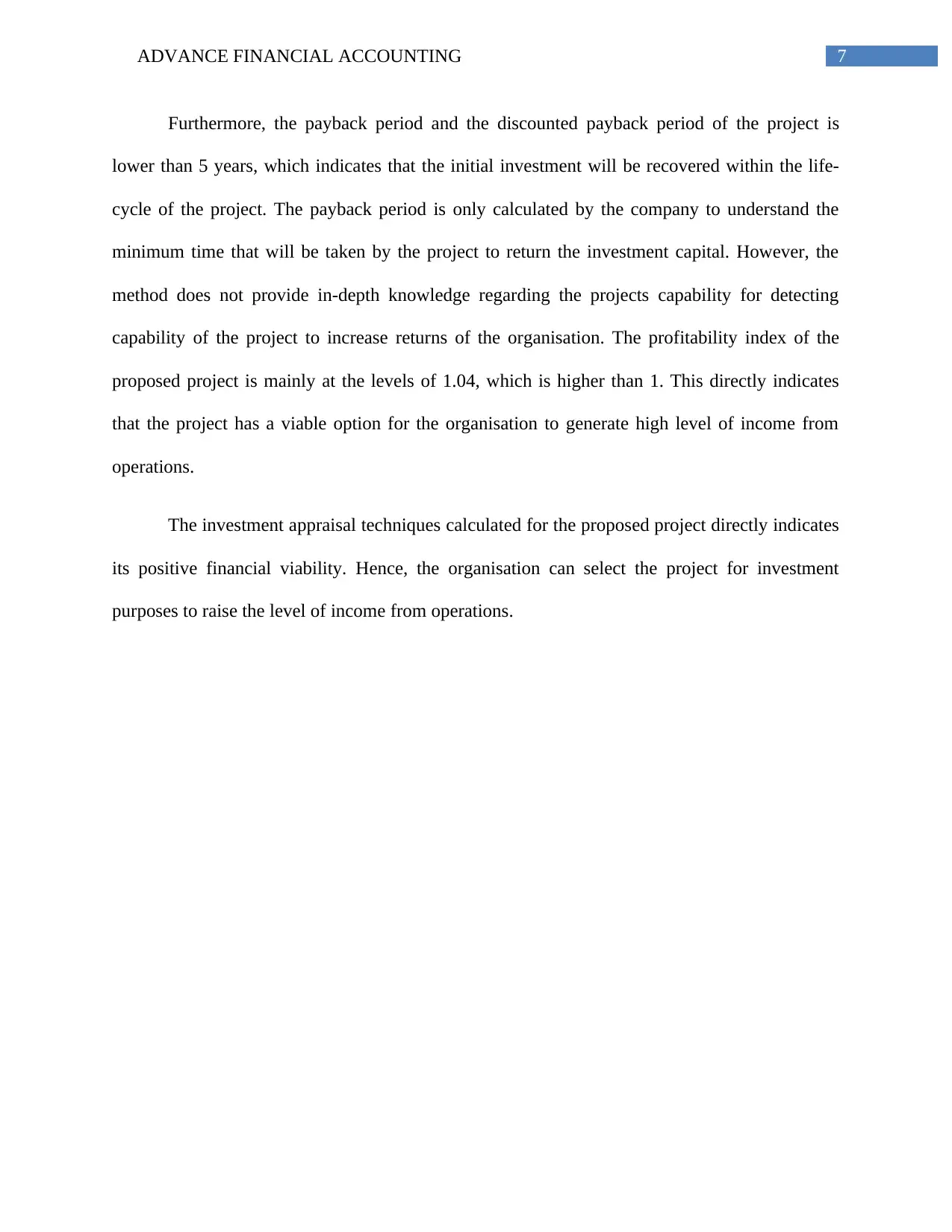
7ADVANCE FINANCIAL ACCOUNTING
Furthermore, the payback period and the discounted payback period of the project is
lower than 5 years, which indicates that the initial investment will be recovered within the life-
cycle of the project. The payback period is only calculated by the company to understand the
minimum time that will be taken by the project to return the investment capital. However, the
method does not provide in-depth knowledge regarding the projects capability for detecting
capability of the project to increase returns of the organisation. The profitability index of the
proposed project is mainly at the levels of 1.04, which is higher than 1. This directly indicates
that the project has a viable option for the organisation to generate high level of income from
operations.
The investment appraisal techniques calculated for the proposed project directly indicates
its positive financial viability. Hence, the organisation can select the project for investment
purposes to raise the level of income from operations.
Furthermore, the payback period and the discounted payback period of the project is
lower than 5 years, which indicates that the initial investment will be recovered within the life-
cycle of the project. The payback period is only calculated by the company to understand the
minimum time that will be taken by the project to return the investment capital. However, the
method does not provide in-depth knowledge regarding the projects capability for detecting
capability of the project to increase returns of the organisation. The profitability index of the
proposed project is mainly at the levels of 1.04, which is higher than 1. This directly indicates
that the project has a viable option for the organisation to generate high level of income from
operations.
The investment appraisal techniques calculated for the proposed project directly indicates
its positive financial viability. Hence, the organisation can select the project for investment
purposes to raise the level of income from operations.
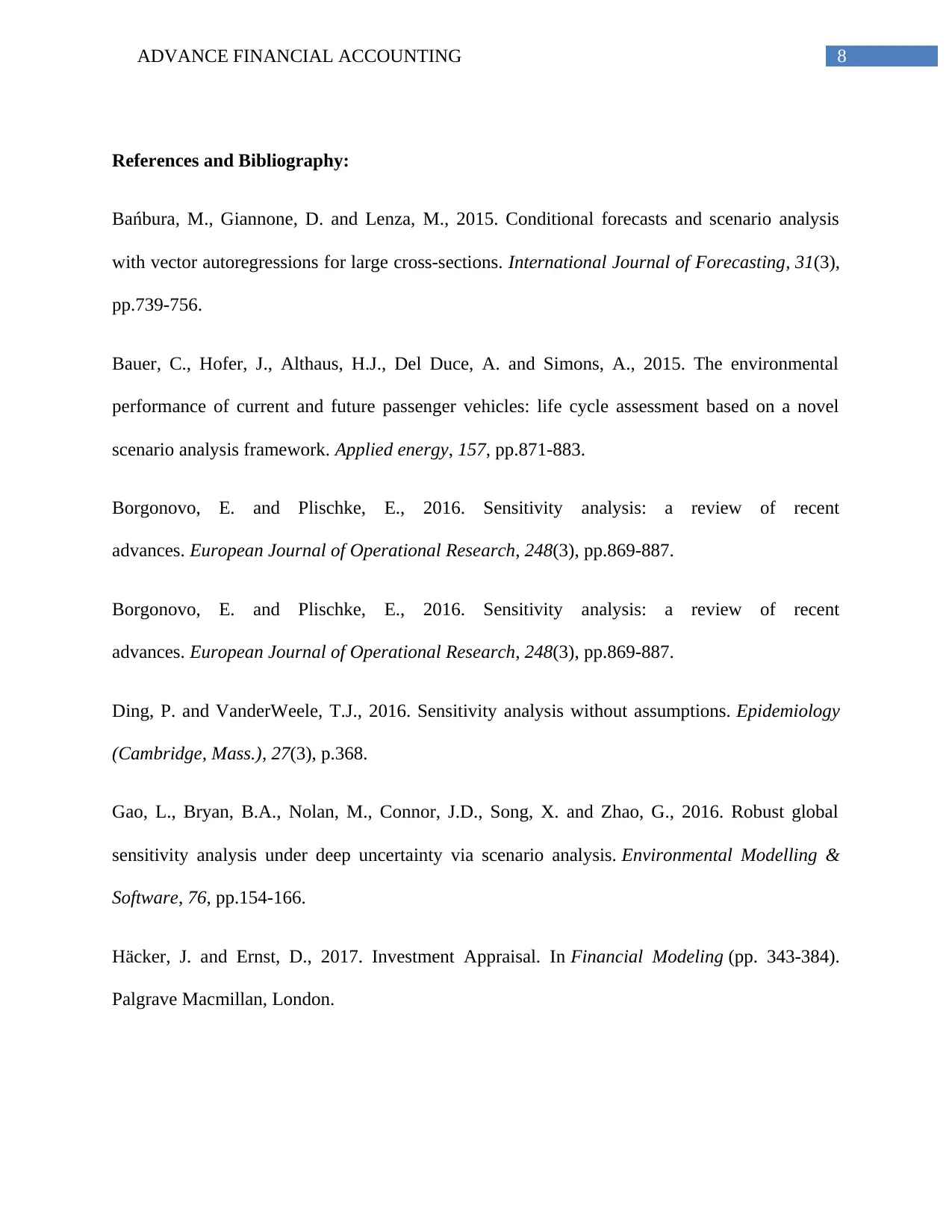
8ADVANCE FINANCIAL ACCOUNTING
References and Bibliography:
Bańbura, M., Giannone, D. and Lenza, M., 2015. Conditional forecasts and scenario analysis
with vector autoregressions for large cross-sections. International Journal of Forecasting, 31(3),
pp.739-756.
Bauer, C., Hofer, J., Althaus, H.J., Del Duce, A. and Simons, A., 2015. The environmental
performance of current and future passenger vehicles: life cycle assessment based on a novel
scenario analysis framework. Applied energy, 157, pp.871-883.
Borgonovo, E. and Plischke, E., 2016. Sensitivity analysis: a review of recent
advances. European Journal of Operational Research, 248(3), pp.869-887.
Borgonovo, E. and Plischke, E., 2016. Sensitivity analysis: a review of recent
advances. European Journal of Operational Research, 248(3), pp.869-887.
Ding, P. and VanderWeele, T.J., 2016. Sensitivity analysis without assumptions. Epidemiology
(Cambridge, Mass.), 27(3), p.368.
Gao, L., Bryan, B.A., Nolan, M., Connor, J.D., Song, X. and Zhao, G., 2016. Robust global
sensitivity analysis under deep uncertainty via scenario analysis. Environmental Modelling &
Software, 76, pp.154-166.
Häcker, J. and Ernst, D., 2017. Investment Appraisal. In Financial Modeling (pp. 343-384).
Palgrave Macmillan, London.
References and Bibliography:
Bańbura, M., Giannone, D. and Lenza, M., 2015. Conditional forecasts and scenario analysis
with vector autoregressions for large cross-sections. International Journal of Forecasting, 31(3),
pp.739-756.
Bauer, C., Hofer, J., Althaus, H.J., Del Duce, A. and Simons, A., 2015. The environmental
performance of current and future passenger vehicles: life cycle assessment based on a novel
scenario analysis framework. Applied energy, 157, pp.871-883.
Borgonovo, E. and Plischke, E., 2016. Sensitivity analysis: a review of recent
advances. European Journal of Operational Research, 248(3), pp.869-887.
Borgonovo, E. and Plischke, E., 2016. Sensitivity analysis: a review of recent
advances. European Journal of Operational Research, 248(3), pp.869-887.
Ding, P. and VanderWeele, T.J., 2016. Sensitivity analysis without assumptions. Epidemiology
(Cambridge, Mass.), 27(3), p.368.
Gao, L., Bryan, B.A., Nolan, M., Connor, J.D., Song, X. and Zhao, G., 2016. Robust global
sensitivity analysis under deep uncertainty via scenario analysis. Environmental Modelling &
Software, 76, pp.154-166.
Häcker, J. and Ernst, D., 2017. Investment Appraisal. In Financial Modeling (pp. 343-384).
Palgrave Macmillan, London.
⊘ This is a preview!⊘
Do you want full access?
Subscribe today to unlock all pages.

Trusted by 1+ million students worldwide

9ADVANCE FINANCIAL ACCOUNTING
Iooss, B. and Lemaître, P., 2015. A review on global sensitivity analysis methods. In Uncertainty
management in simulation-optimization of complex systems (pp. 101-122). Springer, Boston,
MA.
Konstantin, P. and Konstantin, M., 2018. Investment Appraisal Methods. In Power and Energy
Systems Engineering Economics (pp. 39-64). Springer, Cham.
Li, F.G. and Trutnevyte, E., 2017. Investment appraisal of cost-optimal and near-optimal
pathways for the UK electricity sector transition to 2050. Applied energy, 189, pp.89-109.
Locatelli, G., Invernizzi, D.C. and Mancini, M., 2016. Investment and risk appraisal in energy
storage systems: A real options approach. Energy, 104, pp.114-131.
Pianosi, F., Beven, K., Freer, J., Hall, J.W., Rougier, J., Stephenson, D.B. and Wagener, T.,
2016. Sensitivity analysis of environmental models: A systematic review with practical
workflow. Environmental Modelling & Software, 79, pp.214-232.
Pianosi, F., Sarrazin, F. and Wagener, T., 2015. A Matlab toolbox for global sensitivity
analysis. Environmental Modelling & Software, 70, pp.80-85.
Pinngarm, P., Ninsonti, H., Pavasant, P., Jesdapipat, S. and Setthapun, W., 2017. Scenario
analysis for Green City model: Case study of Chiang Mai World Green City Model,
Thailand. Journal of Renewable Energy and Smart Grid Technology, 12(1), pp.23-36.
Upton, J., Murphy, M., De Boer, I.J.M., Koerkamp, P.G., Berentsen, P.B.M. and Shalloo, L.,
2015. Investment appraisal of technology innovations on dairy farm electricity
consumption. Journal of dairy science, 98(2), pp.898-909.
Iooss, B. and Lemaître, P., 2015. A review on global sensitivity analysis methods. In Uncertainty
management in simulation-optimization of complex systems (pp. 101-122). Springer, Boston,
MA.
Konstantin, P. and Konstantin, M., 2018. Investment Appraisal Methods. In Power and Energy
Systems Engineering Economics (pp. 39-64). Springer, Cham.
Li, F.G. and Trutnevyte, E., 2017. Investment appraisal of cost-optimal and near-optimal
pathways for the UK electricity sector transition to 2050. Applied energy, 189, pp.89-109.
Locatelli, G., Invernizzi, D.C. and Mancini, M., 2016. Investment and risk appraisal in energy
storage systems: A real options approach. Energy, 104, pp.114-131.
Pianosi, F., Beven, K., Freer, J., Hall, J.W., Rougier, J., Stephenson, D.B. and Wagener, T.,
2016. Sensitivity analysis of environmental models: A systematic review with practical
workflow. Environmental Modelling & Software, 79, pp.214-232.
Pianosi, F., Sarrazin, F. and Wagener, T., 2015. A Matlab toolbox for global sensitivity
analysis. Environmental Modelling & Software, 70, pp.80-85.
Pinngarm, P., Ninsonti, H., Pavasant, P., Jesdapipat, S. and Setthapun, W., 2017. Scenario
analysis for Green City model: Case study of Chiang Mai World Green City Model,
Thailand. Journal of Renewable Energy and Smart Grid Technology, 12(1), pp.23-36.
Upton, J., Murphy, M., De Boer, I.J.M., Koerkamp, P.G., Berentsen, P.B.M. and Shalloo, L.,
2015. Investment appraisal of technology innovations on dairy farm electricity
consumption. Journal of dairy science, 98(2), pp.898-909.
Paraphrase This Document
Need a fresh take? Get an instant paraphrase of this document with our AI Paraphraser

10ADVANCE FINANCIAL ACCOUNTING
VanderWeele, T.J. and Ding, P., 2017. Sensitivity analysis in observational research: introducing
the E-value. Annals of internal medicine, 167(4), pp.268-274.
VanderWeele, T.J. and Ding, P., 2017. Sensitivity analysis in observational research: introducing
the E-value. Annals of internal medicine, 167(4), pp.268-274.
1 out of 11
Related Documents
Your All-in-One AI-Powered Toolkit for Academic Success.
+13062052269
info@desklib.com
Available 24*7 on WhatsApp / Email
![[object Object]](/_next/static/media/star-bottom.7253800d.svg)
Unlock your academic potential
Copyright © 2020–2026 A2Z Services. All Rights Reserved. Developed and managed by ZUCOL.





